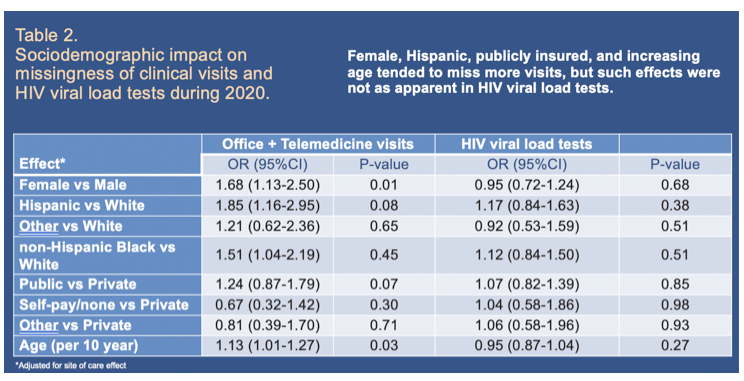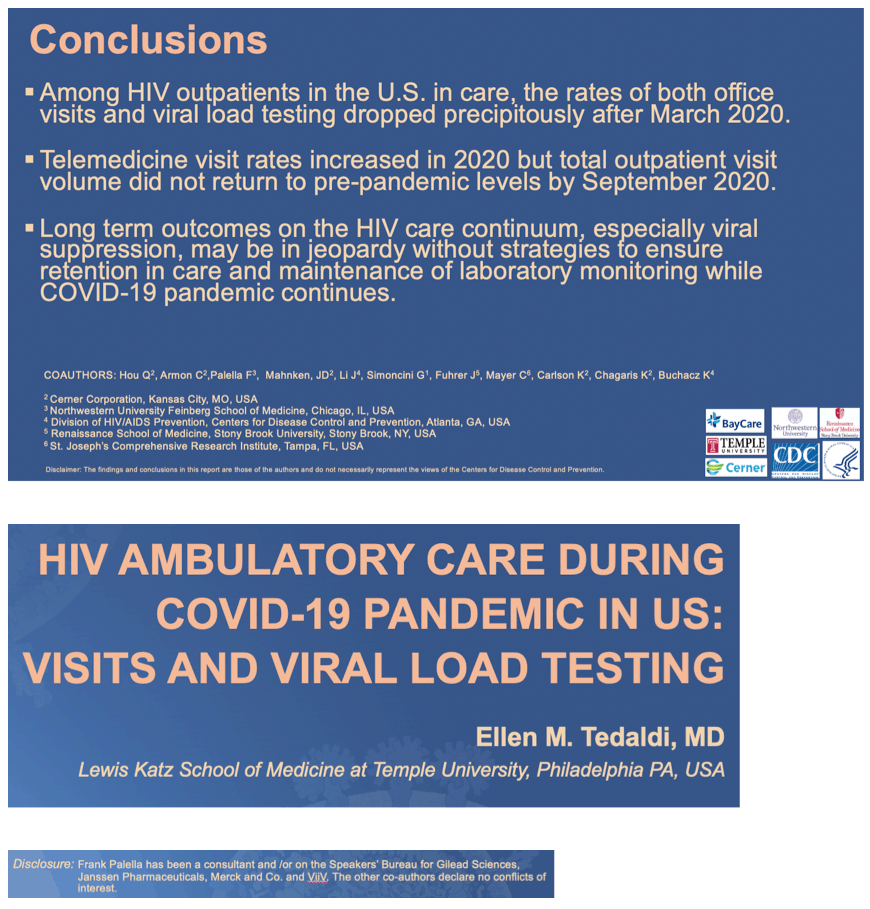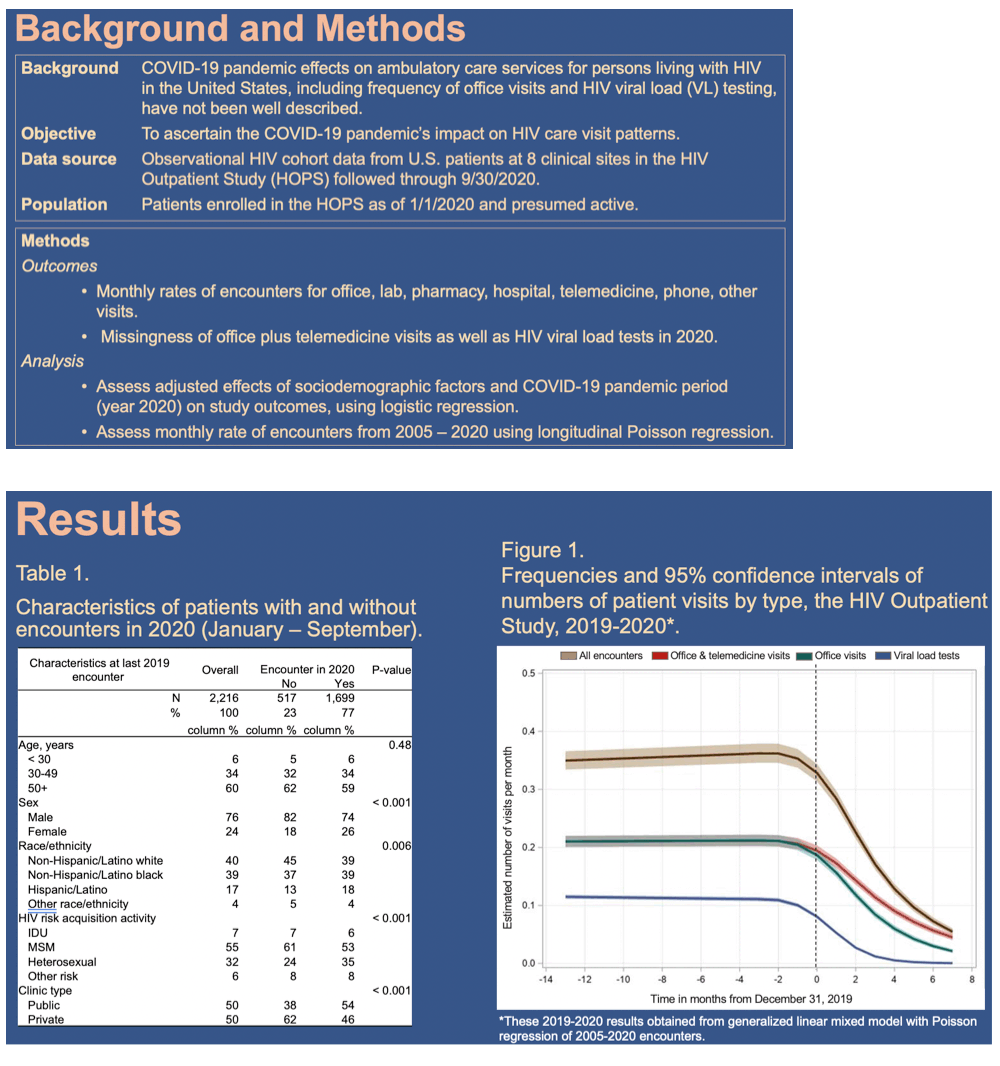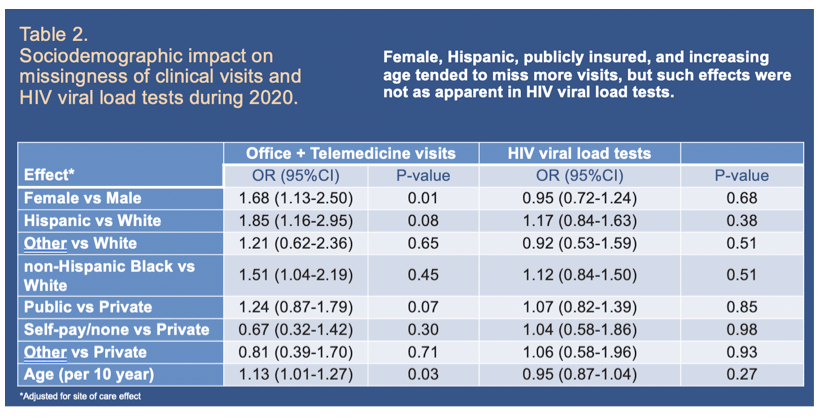 |
 |
 |
| |
HIV AMBULATORY CARE DURING COVID-19 PANDEMIC IN US: VISITS AND VIRAL LOAD TESTING - "dropped precipitously"
|
| |
| |
Ellen M . Tedaldi1, Qingjiang Hou2, Carl Armon2, Frank Palella3, Jun Li4, Gina Simoncini1, Jack Fuhrer5, Cynthia Mayer6, Kimberly J. Carlson2, Kalliope Chagaris2, Kate Buchacz4
1Temple University, Philadelphia, PA, USA, 2Cerner Corporation, Kansas City, MO, USA,3Northwestern University, Chicago, IL, USA, 4Centers for Disease Control and Prevention, Atlanta, GA, USA, 5Stony Brook University, Stony Brook, NY, USA, 6St Joseph's Comprehensive Research Institute, Tampa, FL, USA
Background: COVID-19 pandemic effects on ambulatory care services for persons living with HIV in the United States, including on frequency of office visits and HIV viral load (VL) testing, have not been well described.
Methods: We analyzed longitudinal data of active patients (any encounter after January 1, 2020) at 8 HIV Outpatient Study (HOPS) sites. Monthly rates of all-inclusive encounters (office, lab, pharmacy, hospital, telemedicine [TM], phone, other), office and TM (O&T) visits, and HIV VL tests were derived from generalized linear mixed models, using data available from January 2010
to June 2020. We then assessed temporal trends and the adjusted effects of sociodemographic and clinical factors on the rates of O&T visits during the COVID-19 pandemic, in multivariable Poisson regression of data from January to June 2020.
Results: Of 1251 active patients, 71% were male, 57% aged ≥ 50 years, 36% non-Hispanic white, 42% non-Hispanic black, 19% Hispanic/Latino, and 49% publicly insured. Median CD4 count was 680 cells/mm3 and 93% had suppressed (<200 copies/mL) VL on last test before January 1, 2020. Patients contributed 10,041 person-years of observation from January 2010 to June 2020.
Monthly all-inclusive visit rate (95% Confidence Interval) dropped from 0.33 (0.31, 0.34) in December 2019 to 0.17 (0.16, 0.18) in March 2020, and further declined to 0.07 (0.07, 0.08) in June 2000. The monthly TM rate increased from 0.7% in December 2019 to 2.7% in June 2020 (Figure). In Poisson regression of 2020 data, monthly rate for O&T visits decreased from January to March by 32% and then by another 10% from March to June 2020 (both p<0.001). The decrease was lower with increasing age by 1% (0.5%, 1.5%) per year (p<0.001), and was greater (by 16%) for patients at private clinics than public sites (p<0.05), but did not differ by insurance type, sex, race/ethnicity, or presence of VL suppression on last test (all p>0.20). The increase in TM visits (2%) did not offset the decline in office visits (26%). The HIV VL testing rate fell by 50% in the first 6 months of 2020 among patients who had VL test done in 2019 (Figure).
Tended to miss more visits: females, hispanics, publicly insured and those of increasing age.

Conclusion: In the HOPS, the rates of office visits and HIV VL tests dropped precipitously after March 2020. The long-term implications for clinical outcomes and HIV viral suppression may not be evident at this time in the COVID-19 pandemic but HIV care sites need strategies to ensure patients maintain engagement in care and HIV laboratory monitoring.



|
| |
|
 |
 |
|
|